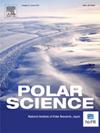Molecular signatures of environmental adaptation mechanisms of Rhizocarpon geographicum in Horseshoe Island (west of the Antarctic Peninsula) and Türkiye
IF 1.5
4区 地球科学
Q3 ECOLOGY
引用次数: 0
Abstract
The adaptation of lichen species to different habitats and extreme conditions is due to rapid changes in expressions of the genes in their genetic backgrounds. In this study, lichen samples were collected from two different regions: from Horseshoe Island, located to the west of the Antarctic Peninsula and from the west coast of Türkiye. The nrITS gene regions of the samples were studied and the phylogenetic positions of the samples were confirmed as Rhizocarpon geographicum (L.) DC. After DNA barcoding of R. geographicum, expression differences of three below-specified stress genes were revealed. Comparative determinations of the changes in the expressions of the multiprotein binding factor-1 (MBF-1), polyketide synthase (PKS), and photosystem II D1 protein (psbA) genes due to temperature or other environmental stress change stress were performed by a real-time PCR. Specifically, under cold stress conditions such as those found on Horseshoe Island, the MBF-1 gene was highly expressed, while PKS and psbA gene expression levels were lower compared to the west coast of Türkiye. The results of this study, which is the first in its field, highlight the adaptation of Rhizocarpon geographicum specimens to those habitats and regional climate. Specimen collected from different geographical regions exhibited gene expression differences.
马蹄铁岛(南极半岛西部)和 rkiye地区地理根茎霉环境适应机制的分子特征
地衣物种对不同生境和极端条件的适应是由于其遗传背景中基因表达的快速变化。在这项研究中,地衣样本是从两个不同的地区收集的:位于南极半岛西部的马蹄岛和t rkiye西海岸。对样品的nrITS基因区域进行了研究,确定了样品的系统发育位置为Rhizocarpon geographicum (L.)。直流。对地瓜进行DNA条形码分析,揭示了3个特定胁迫基因的表达差异。采用实时荧光定量PCR法比较测定温度或其他环境胁迫变化对多蛋白结合因子-1 (MBF-1)、多酮合成酶(PKS)和光系统II D1蛋白(psbA)基因表达的影响。具体而言,在马蹄铁岛等寒冷胁迫条件下,MBF-1基因表达量高,而PKS和psbA基因表达水平低于 rkiye西海岸。本研究在该领域尚属首次,突出了根卡蓬地理标本对这些生境和区域气候的适应性。来自不同地理区域的标本表现出基因表达的差异。
本文章由计算机程序翻译,如有差异,请以英文原文为准。
求助全文
约1分钟内获得全文
求助全文
来源期刊

Polar Science
ECOLOGY-GEOSCIENCES, MULTIDISCIPLINARY
CiteScore
3.90
自引率
5.60%
发文量
46
期刊介绍:
Polar Science is an international, peer-reviewed quarterly journal. It is dedicated to publishing original research articles for sciences relating to the polar regions of the Earth and other planets. Polar Science aims to cover 15 disciplines which are listed below; they cover most aspects of physical sciences, geosciences and life sciences, together with engineering and social sciences. Articles should attract the interest of broad polar science communities, and not be limited to the interests of those who work under specific research subjects. Polar Science also has an Open Archive whereby published articles are made freely available from ScienceDirect after an embargo period of 24 months from the date of publication.
- Space and upper atmosphere physics
- Atmospheric science/climatology
- Glaciology
- Oceanography/sea ice studies
- Geology/petrology
- Solid earth geophysics/seismology
- Marine Earth science
- Geomorphology/Cenozoic-Quaternary geology
- Meteoritics
- Terrestrial biology
- Marine biology
- Animal ecology
- Environment
- Polar Engineering
- Humanities and social sciences.
 求助内容:
求助内容: 应助结果提醒方式:
应助结果提醒方式:


